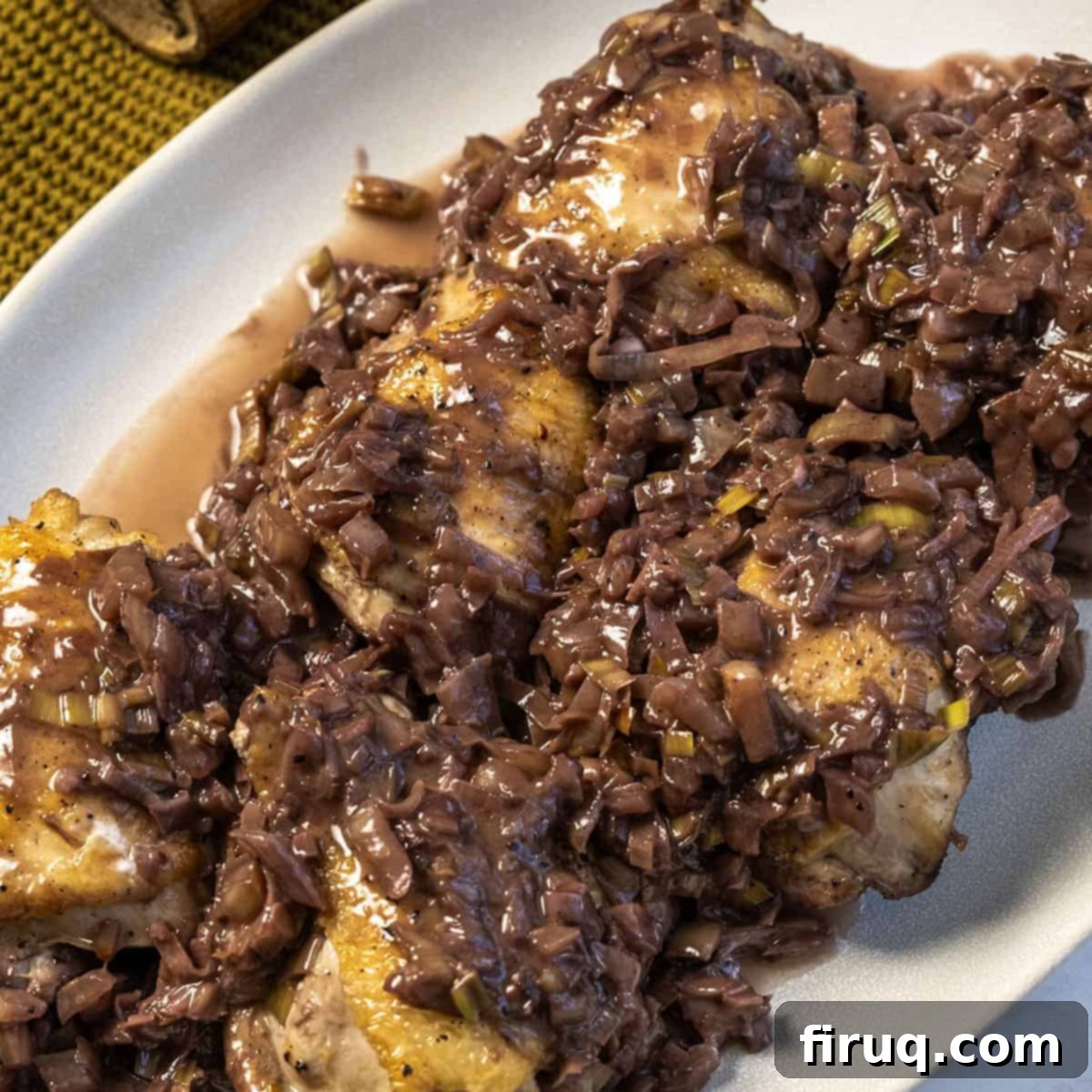Braised Fennel Chicken Thighs in Red Wine Sauce: An Ancient Italian Recipe Reinvented
Prepare to be utterly captivated by a dish whose unassuming appearance belies its incredible depth of flavor: Fennel Chicken Thighs in Red Wine. This recipe delivers a symphony of savory notes, with succulent chicken thighs perfectly braised and generously topped with a rich, creamy fennel and leek red wine sauce. It’s a dish that transcends the ordinary, offering an intensely satisfying and deeply aromatic experience that will impress even the most discerning palates.
While the unique combination of fennel and red wine might not be as universally recognized as some classic pairings, its taste profile is just as delightful and sophisticated as our Creamy Lemon Sauce. This savory, intensely flavored dish finds its perfect companion in a robust Cabernet Sauvignon, and pairs beautifully with our Garlic Parmesan Green Beans for a complete and unforgettable meal.
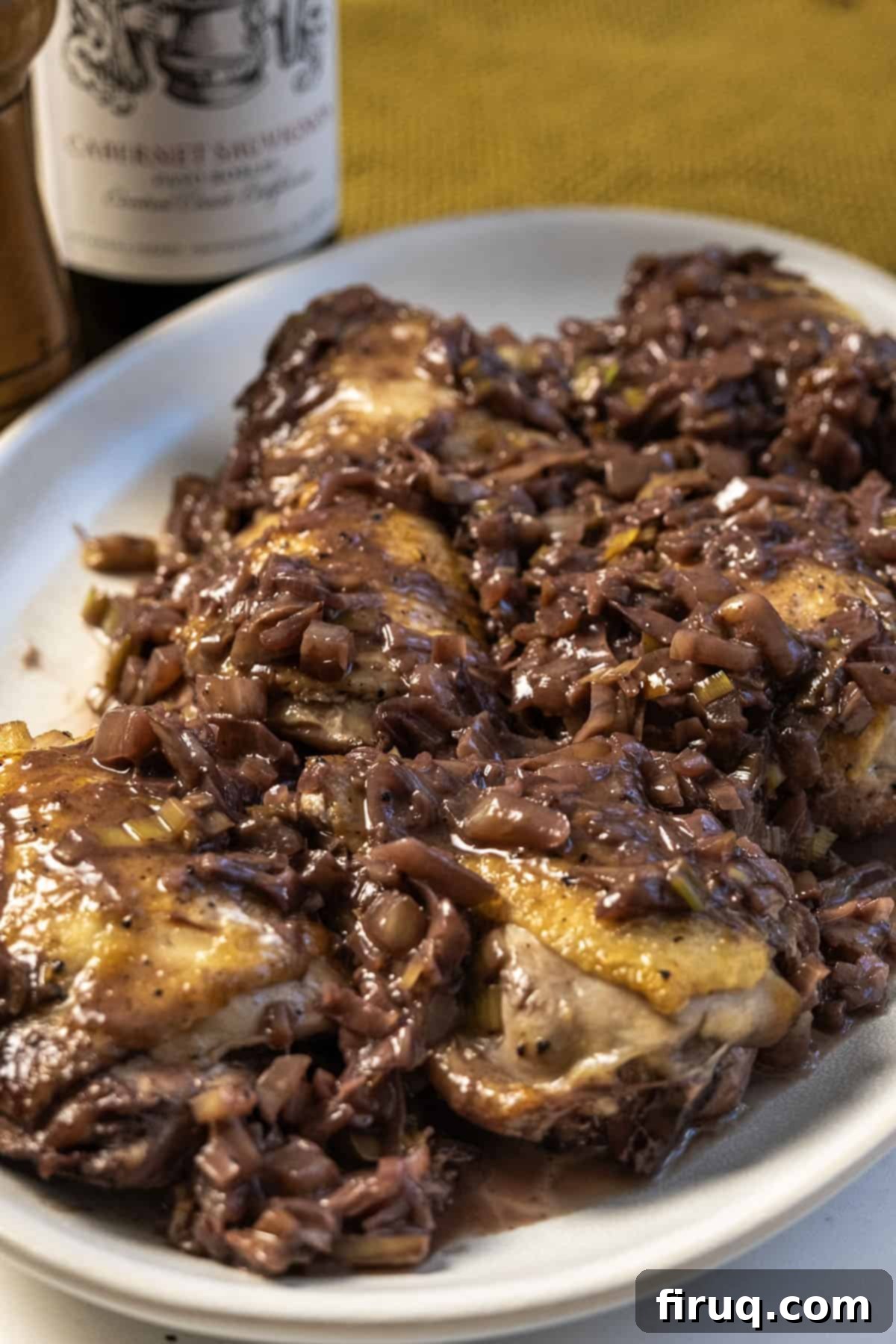
For those who revel in hearty, flavorful chicken dishes, you’ll find this recipe to be a delightful addition to your culinary repertoire. If you enjoy rich, slow-cooked flavors, you may also appreciate our Cast Iron Lemon Basil Orzo with Chicken Thighs or the robust flavors of Restaurant-Style Chicken Scarpariello. These dishes share a common thread of comforting warmth and deep, satisfying tastes that make them perfect for family dinners or entertaining guests.
Apicius De Re Coquinaria: A Taste of Ancient Rome
This exquisite recipe for fennel chicken thighs in red wine draws its inspiration from an extraordinary source: Apicius De Re Coquinaria. This isn’t just any cookbook; it is widely regarded as the oldest surviving collection of Roman recipes, offering a fascinating glimpse into the culinary practices of the Roman Empire. The book itself is named after Apicius, a legendary figure from the First Century AD, celebrated for his profound love of luxury and his relentless pursuit of gourmet excellence.
Apicius’s cookbook is a treasure trove of historical dishes, a compilation of his carefully curated recipes that showcase the sophisticated tastes of ancient Rome. Our particular recipe is a modern interpretation of a dish originally known as Fronto Chicken. Given its ancient origins, we’ve naturally had to adapt certain ingredients to suit contemporary availability and palates. For instance, the original garum, a potent fermented fish sauce, has been thoughtfully replaced with more accessible anchovy paste, and grape must has been substituted with readily available red wine. Despite these modern adjustments, the essence of the ancient dish remains. Interestingly, another recipe from this very same book, known as “Polus,” is the precursor to what we now enjoy as Classic Italian Minestrone, highlighting the enduring legacy of Roman culinary traditions.
Understanding garum is key to appreciating this recipe’s historical roots. It was an ancient Roman fish sauce, essentially fermented fish, highly prized for its intense umami flavor. However, the traditional methods of its preparation, which involved long fermentation processes in the sun, would likely deter many modern diners. Therefore, we opt for anchovy paste as a practical and flavorful substitute. While anchovy paste has its distinct profile, it brilliantly captures that deep, savory umami richness that garum would have imparted, enriching the dish with a complexity that is hard to achieve otherwise. It’s a small, modern tweak that honors the spirit of ancient Roman cooking while making it palatable for today’s kitchen.
Ingredient Notes and Substitutions for Perfect Fennel Chicken
Achieving the rich, layered flavors of this braised chicken dish relies on a few key ingredients. Here’s a deeper look into what makes them special and how to best use them.
Fennel and Leeks. These two vegetables are often overlooked in favor of more common aromatics like onions and celery, but their unique contribution to this dish is simply unparalleled. Fennel offers a distinct, delicate licorice or anise-like flavor, which softens and sweetens beautifully as it cooks, transforming into a subtle, almost ethereal sweetness. Leeks, with their milder, sweeter onion flavor, complement the fennel perfectly, adding an extra layer of aromatic complexity. The flavor punch they provide is absolutely worth experimenting with. My appreciation for fennel truly deepened after trying it in our Rustic Italian Tortellini Soup with Sausage!
Anchovy paste. We understand that the mention of anchovies can sometimes be polarizing. While some might prefer to omit anchovies from dishes like pizza, in a slow-braised recipe like this, it’s absolutely essential and completely transformative. We strongly encourage you to give it a try. The “fish” flavor completely disappears during the long cooking process, melding seamlessly into the sauce. What remains is a profound, almost indescribable savoriness – a deep umami that elevates the entire dish and adds a complexity that is truly hard to replicate with any other ingredient. It’s the secret weapon that connects this modern rendition to its ancient Roman roots, providing that crucial depth of flavor.
Dry Red Wine. The choice of red wine is critical here. A good quality dry red wine, such as a Cabernet Sauvignon or Merlot, not only provides the braising liquid but also adds significant depth, acidity, and fruit notes to the sauce. These wines are full-bodied enough to stand up to the rich chicken and aromatic vegetables without being overpowering. The wine reduces and concentrates its flavors, becoming an integral part of the creamy sauce. Avoid sweet wines, as they will alter the intended savory balance of the dish.
Step-by-Step Directions for Fennel Chicken Thighs
Follow these detailed steps to create a perfectly braised, flavorful chicken dish that will impress every time.
Begin by setting your saucepan over medium-high heat and adding the olive oil. This initial heat is crucial for developing a beautiful sear on the chicken. Before placing the chicken in the pan, make sure to thoroughly dry the chicken thighs with a paper towel. This vital step removes excess moisture, which prevents the chicken from steaming and instead promotes a truly crisp, golden-brown sear on the skin, locking in juices and adding a layer of texture and flavor.
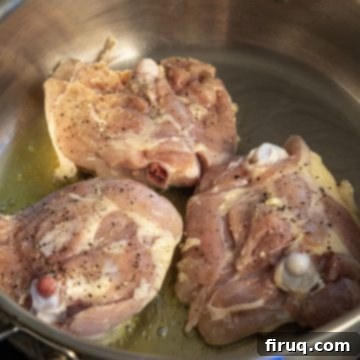
Step 1: Sear the Chicken. Generously season the chicken on both sides with salt and freshly ground black pepper. Carefully place the chicken, skin-side down, into the hot pan. Let it sear undisturbed for 3-4 minutes on each side until a deep golden-brown crust forms. It’s important not to overcrowd the pan, so you may need to do this in batches to ensure proper searing. Once seared, remove the chicken from the pan and set them aside. They will not be fully cooked at this stage, as their cooking will finish in the braising liquid, allowing them to become incredibly tender and flavorful.
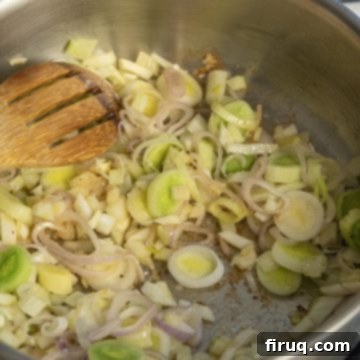
Step 2: Sauté the Aromatics. Reduce the heat to medium. Add the chopped fennel, sliced leeks, and shallots to the pan. Season generously with salt and pepper. Sauté these aromatics, stirring occasionally, until they are beautifully softened and have begun to caramelize, which should take approximately 8 minutes. This slow cooking allows their natural sugars to develop, building a sweet and savory base for your sauce.
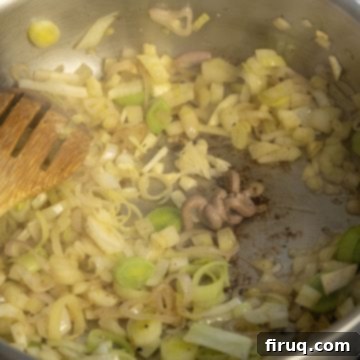
Step 3: Build the Flavor Base. To the softened vegetables, add the minced garlic and anchovy paste. Sauté for another minute or two, stirring constantly. This brief cooking time is enough to mellow the raw garlic flavor and allow the anchovy paste to dissolve and infuse its incredible umami into the foundation of your sauce without developing any “fishy” taste.
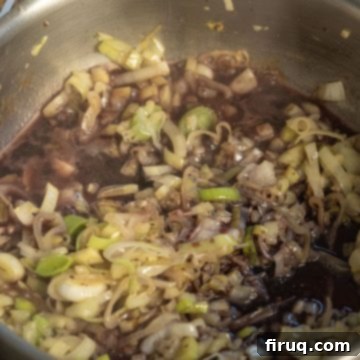
Step 4: Deglaze with Red Wine. Carefully pour in the dry red wine. Bring the mixture to a gentle simmer, scraping the bottom of the pan with a wooden spoon to release any browned bits (fond) that have accumulated. These flavorful bits will dissolve into the wine, adding even more depth and richness to your sauce. Allow it to simmer for a few minutes, letting the alcohol cook off and the flavors meld.
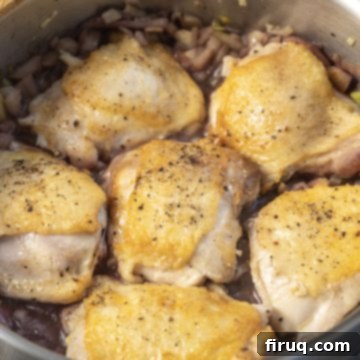
Step 5: Braise the Chicken. Gently add the seared chicken thighs back to the pan, nestling them into the simmering red wine sauce. Ensure the chicken is partially submerged (about ¼ covered) in the liquid. Cover the pan and let it simmer gently for 20-25 minutes, or until the chicken thighs reach an internal temperature of 165℉. This slow braising process will make the chicken incredibly tender, moist, and deeply infused with the rich flavors of the sauce.
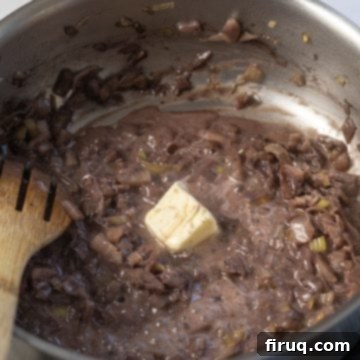
Step 6: Finish the Sauce. Once the chicken is cooked through, carefully remove the chicken thighs from the pan and keep them warm. Now, it’s time to perfect your luscious sauce. Add the butter to the remaining sauce in the pan. Stir continuously until the butter is fully melted and incorporated, creating a rich, glossy, and slightly thickened sauce. The butter not only adds a wonderful richness but also helps to emulsify the sauce, giving it a smooth, velvety texture. Spoon this exquisite sauce generously over the chicken, and prepare to be amazed.
Fennel, with its distinctive aroma and delicate taste, is truly an underrated ingredient, especially in American-Italian cooking. If you’re discovering a newfound love for this versatile vegetable, you absolutely must try it in our Sausage and Fennel Pasta, where its unique flavor shines brilliantly, offering a different yet equally delicious experience.
Pro-Tips for Perfect Braised Chicken
Mastering this dish is simple with a few expert tips:
- Maintain Braising Liquid Levels: The liquid level is crucial for tender, moist chicken. If your red wine sauce has reduced significantly before you add the chicken thighs back, don’t hesitate to add a little water or chicken broth to the pan. The chicken should be about ¼ covered in the sauce while braising. This ensures even cooking and prevents the chicken from drying out, allowing it to fully absorb the rich flavors of the sauce.
- Achieve the Perfect Sear: When searing chicken, resist the urge to move them constantly. Place the chicken skin-side down and allow them to sear untouched for at least 3 minutes before you even think about lifting them to check underneath. This patience will be rewarded with a beautiful, deeply golden-brown, and crispy skin, which adds incredible texture and flavor to the finished dish. Overcrowding the pan can also lower the temperature, so work in batches if necessary.
- Trust the Anchovy Paste: As mentioned, anchovy paste is a secret weapon here. It will not make your dish taste like fish. Instead, it melts into the sauce, providing an unparalleled depth of umami and a savory backbone that enhances all the other flavors. Don’t skip it; it’s a small addition that makes a huge difference in the complexity of the sauce.
- Don’t Overcook: Use a meat thermometer to ensure your chicken reaches exactly 165℉. Overcooked chicken can become dry and stringy. Braising helps keep it moist, but monitoring the temperature guarantees perfect tenderness.
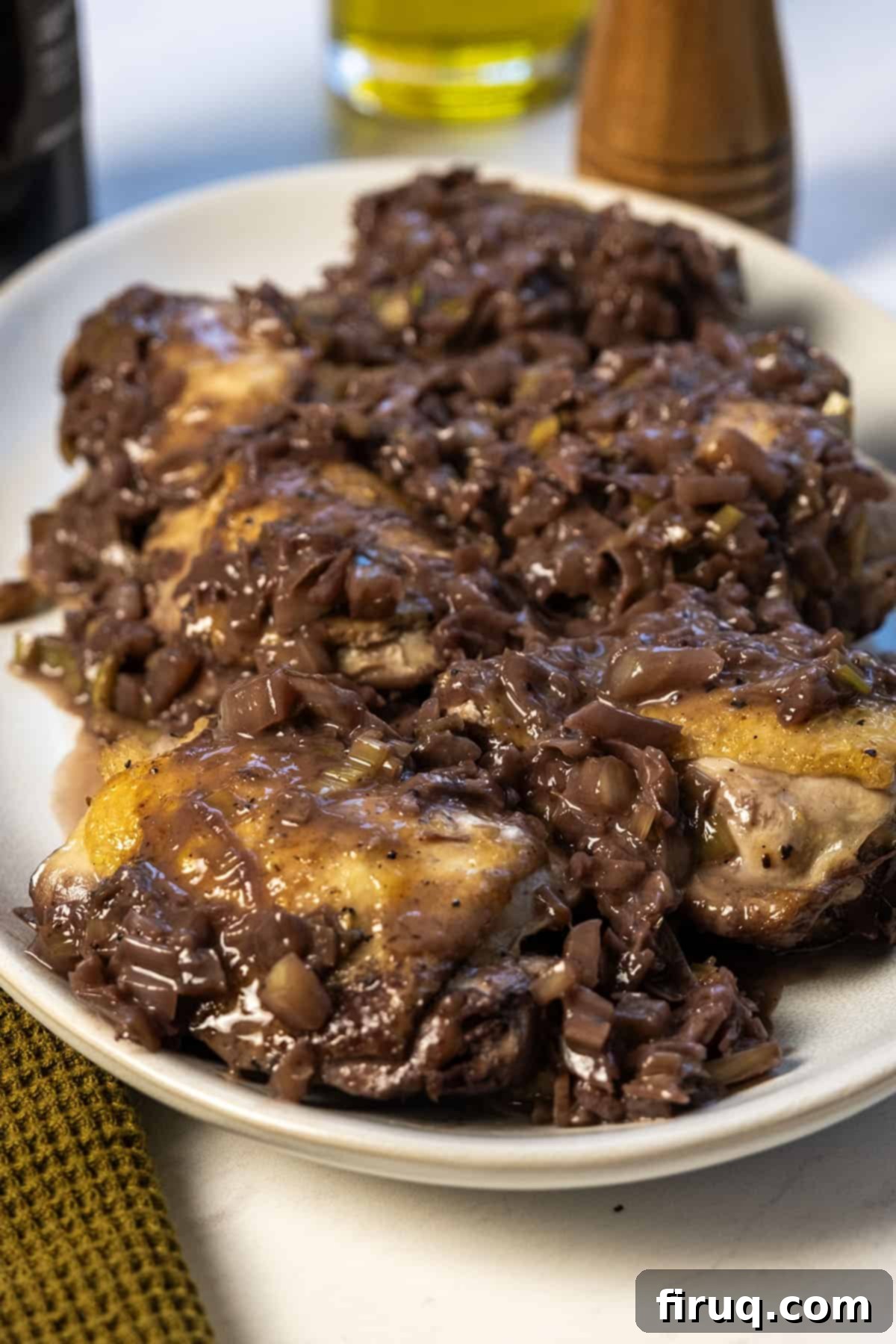
Side Dishes to Pair with Fennel Red Wine Chicken
This rich and savory chicken dish deserves equally robust and complementary side dishes. Here are some fantastic options to complete your meal:
Starch Accompaniments
To truly savor the creamy red wine sauce, a starchy side is essential for soaking up every delicious drop. Serve these fennel chicken thighs alongside some of our comforting favorites like Crispy Garlic Parmesan Potatoes, which offer a delightful crunch and savory counterpoint. Alternatively, opt for the bright and fresh flavors of Lemon Spinach Orzo for a lighter touch, or elevate the experience with something more intensely flavorful like a luxurious Creamy Mushroom Truffle Risotto, whose earthy notes will harmonize beautifully with the fennel and red wine.
Fresh & Hearty Vegetables
Balance the richness of the chicken with vibrant and flavorful vegetable sides. Add this dish along with another old-school Italian vegetable preparation like Italian Cabbage, which offers a tender, savory bite. Or, for a slightly bitter and garlicky contrast, Sautéed Rapini with Garlic is an excellent choice. If you prefer a more comforting, soupy side, a bowl of Classic Pasta Fagioli offers a hearty and traditional Italian accompaniment.
Delightful Appetizers
Before diving into the main course, consider starting your meal with some light and fresh seafood appetizers that won’t overshadow the main event. This dish pairs wonderfully with savory Italian Stuffed Baked Clams, offering a hint of the sea and a touch of elegance. Another excellent choice is a classic Homemade Shrimp Cocktail, providing a refreshing and zesty start that primes the palate for the rich flavors to come.
Recipe FAQs: Frequently Asked Questions
Fennel has a wonderfully unique and often misunderstood flavor. It possesses a mild licorice or anise taste, which is more delicate and sweet than that of black licorice. Think of the subtle, sweet undertone you might find when eating a sweet Italian sausage. When cooked, fennel softens considerably and its flavor mellows and sweetens even further, losing any harshness and becoming a delightful aromatic addition to savory dishes.
While nothing will truly replicate the precise depth and umami richness that anchovy paste provides in this dish, especially given its historical significance to the recipe, you can try alternatives for a similar savory boost. Worcestershire sauce is a common substitute that offers a fermented, savory note. Another option is a small amount of soy sauce, which also contributes umami. However, be mindful that both substitutions will introduce their own distinct flavors, so start with a small amount and adjust to taste.
For this deeply flavored chicken dish, a full-bodied dry red wine is ideal. A Cabernet Sauvignon or a Merlot will work perfectly, contributing robust fruit notes and tannins that stand up well to the richness of the chicken and the sauce. While Pinot Noir can be a dry red wine, it’s generally lighter-bodied and might not provide the necessary structure and depth of flavor required for this particular recipe.
Store chicken thighs and their accompanying sauce in an airtight container in the refrigerator for up to 4 days. This dish often tastes even better the next day as the flavors continue to meld. To reheat, gently warm the chicken and sauce in a saucepan over medium-low heat until the chicken returns to an internal temperature of 165 degrees Fahrenheit. When reheating, you may find that the sauce has thickened considerably in the refrigerator, so you may need to add a splash of water or chicken broth to achieve your desired consistency.
Video Recipe
More Classic Italian Recipes
- Fried Flounder Oreganata
- Authentic Italian Braciole
- Better Than Olive Garden Eggplant Parmigiana
- Busiate with Pesto Trapanese
📖 Recipe
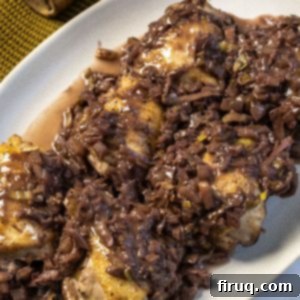
Fennel Chicken Thighs Braised in Red Wine
Vincent DelGiudice
Pin Recipe
Equipment
-
1 large saucepan
Ingredients
- 6 bone-in chicken thighs
- 1 cup dry red wine
- 1 fennel bulb, chopped
- 2 leeks, sliced
- 1 shallot, sliced
- 2 cloves garlic, minced
- 1 tablespoon anchovy paste
- salt and pepper
- 2 tablespoon olive oil
- 2 tbsp butter
Instructions
-
Heat a large saucepan with 2 tablespoons of olive oil over medium-high heat. Pat the chicken thighs thoroughly dry with a paper towel. Season both sides generously with salt and pepper. Place the chicken skin-side down in the hot pan and sear for 3-4 minutes per side, until a deep golden-brown crust forms. Work in batches if necessary to avoid overcrowding. Remove the seared chicken and set aside; it will finish cooking later.
-
Reduce the heat to medium. Add the chopped fennel, sliced leeks, and shallots to the pan. Season with salt and pepper, then sauté for about 8 minutes, stirring occasionally, until the vegetables are softened and begin to caramelize. Next, add the minced garlic and anchovy paste, and sauté for another 1-2 minutes until fragrant, allowing the anchovy paste to melt into the vegetables.
-
Pour in the dry red wine, scraping up any browned bits from the bottom of the pan to deglaze. Bring the liquid to a gentle simmer. Return the seared chicken thighs to the pan, nestling them into the sauce. Cover the pan and continue to simmer for 20-25 minutes, or until the chicken thighs reach an internal temperature of 165℉. Ensure the chicken is about ¼ covered by the sauce during braising.
-
Once the chicken is cooked, carefully remove the thighs from the pan and keep them warm. Add the 2 tablespoons of butter to the simmering sauce. Stir continuously until the butter is fully melted and incorporated, creating a rich, creamy, and glossy sauce. Spoon the luscious sauce generously over the chicken thighs and serve immediately.
Notes
- You may need to add a little water or chicken broth to the pan once you add your chicken thighs in if you let the wine reduce too much. The chicken should be about ¼ covered in the sauce while braising.
- Trust the anchovy paste! This essential ingredient will not make your dish taste like fish but will instead impart a deep, savory umami that makes the sauce incredibly delicious and complex.
Nutrition
We hope you’ve enjoyed this culinary journey back in time, reinventing an ancient Roman dish for your modern table. These Braised Fennel Chicken Thighs in Red Wine are more than just a meal; they’re an experience of deep, layered flavors and tender perfection. Don’t be shy to experiment with these unique ingredients, as they truly unlock a new dimension of taste. Share this delightful dish with loved ones and savor the rich history and incredible flavor that each bite offers!
